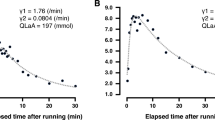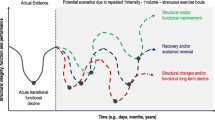Summary
Traditionally, the pulmonary system has not been considered the limiting factor in determining maximal oxygen uptake (V̇2max) in healthy individuals since arterial oxygen-haemoglobin saturation is thought to remain high during intense exercise. However, there appears to be a major exception to this rule. Recent evidence suggests that arterial hypoxaemia results during heavy exercise in well trained individuals with a high V̇2max. Further, the degree of arterial desaturation is inversely related to V̇2max. This exercise-induced hypoxaemia does not appear to be due to hypoventilation although athletes who have limited hyperventilation seem to exhibit the lowest arterial oxygen-haemogloblin saturation. A significant venoarterial shunt has been ruled out as a primary cause of the hypoxaemia based on both experimental and theoretical considerations. Therefore, it appears that the exercise-induced hypoxaemia seen in highly trained athletes during heavy exercise is primarily due to diffusion limitations and ventillation-perfusion inequality. It is postulated that incomplete diffusion in the healthy lung may be due to a rapid red blood cell transit time through the pulmonary capillary. In summary, recent findings suggest that the limits of the human pulmonary system may be reached or even exceeded during intense exercise in some individuals. In light of these findings the role of the pulmonary system as a limiting factor during maximal exercise in the highly trained endurance athlete warrants further investigation.
Similar content being viewed by others
References
Asmussen E, Nielson M. Alveolar-arterial gas exchange at rest and during work at different O2 tensions. Acta Physiologica Scandinavica 50: 153–166, 1960
Åstrand PO, Rodahl K. Textbook of Work Physiology, p. 237, McGraw Hill, New York, 1977
Bachofen H, Hobi HJ, Scherrer M. Alveolar-arterial N2 gradients at rest and during exercise in healthy men of different ages. Journal of Applied Physiology 34: 137–142, 1973
Bake B, Bjure J, Widimsky J. The effect of sitting and graded exercise on the distribution of pulmonary blood flow in healthy subjects studied with the 133Xenon technique. Scandinavian Journal of Clinical Laboratory Investigation 22: 99–106, 1968
Barr PO, Beckman M, Bjurstedt H, Brismar J, Hesser CM, et al. Time courses of blood gas changes provoked by light and moderate exercise in man. Acta Physiologica Scandinavica 60: 1–17, 1964
Bender PR, Martin BJ. Maximal ventilation after exhaustive exercise. Med. Sci. Sports Exerc. 17: 164–167, 1985
Berend N, Christopher KL, Voelkel NF. Breathing He-O2 shifts the lung pressure-volume curve of the dog. Journal of Applied Physiology 54: 576–581, 1983
Bjurstedt H, Wigertz O. Dynamics of arterial oxygen tension in response to sinusoidal work load in man. Acta Physiologica Scandinavica 82: 236–249, 1971
Bryan AC, Bentivoglio LG, Beerd F, MacLeish H, Zidulka A, et al. Factors affecting regional distribution of ventilation and perfusion in the lung. Journal of Applied Physiology 19: 395–402, 1964
Buick F, Gledhill N, Froese A, Spriet L, Myers E. Effect of induced erythrocythemia on aerobic work capacity. Journal of Applied Physiology 48: 636–642, 1980
Bye PTD, Farkas GA, Roussos C. Respiratory factors limiting exercise. Annual Review of Physiology 45: 439–451, 1983
Byrae-Quinn E, Weil JV, Sodal I, Filley G, Grover R. Ventilatory control in the athlete. Journal of Applied Physiology 30: 91–95, 1971
Dempsey JA. Is the lung built for exercise? Medicine and Science in Sports and Exercise 18: 143, 1986
Dempsey JA, Fregosi R. Adaptability of the pulmonary system to changing metabolic requirements. American Journal of Cardiology 55: 59D–67D, 1985
Dempsey JA, Hanson PG, Henderson KS. Exercise-induced arterial hypoxemia in healthy persons at sea level. Journal of Physiology (London) 355: 161–175, 1984
Dempsey JA, Hanson PE, Pegelow C, Claremont A. Limitations to exercise capacity and endurance: pulmonary system. Canadian Journal of Applied Sports Sciences 7: 4–13, 1982
Dempsey JA, Reddan WG, Rankin J, Balke B. Alveolar-arterial gas exchange during muscular work in obesity. Journal of Applied Physiology 21: 1807–1814, 1966
Dempsey JA, Vidruk EH, Mastenbrook SM. Pulmonary control systems in exercise. Federation Proceedings 39: 1498–1501, 1980
Ekblom B, Hermansen L. Cardiac output in athletes. Journal of Applied Physiology 25: 619–625, 1968
Gale GE, Torre-Bueno JR, Moon RE, Saltzman HA, Wagner PD. Ventilation-perfusion inequality in normal humans during exercise at sea level and simulated altitude. Journal of Applied Physiology 58: 978–988, 1985
Gledhill N, Froese AB, Buick FJ, Bryan AC. VA.Q inhomogeneity and AaD02 in man during exercise: the effects of SF6 breathing. Journal of Applied Physiology 45: 512–515, 1978
Gledhill N, Froese AB, Dempsey JA. Ventilation to perfusion distribution during exercise in health. In Dempsey and Reed (Eds) Muscular Exercise and the Lung, pp. 325–343, University of Wisconsin Press, Madison, 1977
Gledhill N, Spriet LL, Froese AB, Wilkes DL, Meyers EC. Acidbase status with induced erythrocemia and its influence on arterial oxygenation during heavy exercise. Abstract. Medicine and Science in Sports and Exercise 12: 122, 1980
Goforth H, Campbell N, Hodgdon J, Sucec A. Hematologic parameters of trained distance runners following induced erythrocythemia. Abstract. Medicine and Science in Sports and Exercise 14: 174, 1982
Goresky CA, Warnica JW, Burgess JH, Cronin RFP, Nadeau BE. Changes in extravascular water volume and CO2 diffusion capacity during exercise in man. Abstract. Federation Proceedings 31: 307, 1972
Hanson P, Claremont A, Dempsey J, Reddan W. Determinants and consequences of ventilatory responses to competitive endurance running. J. Appl. Physiol. 52: 615–623, 1982
Hesser CM, Matell G. Effect of light and moderate exercise on alveolar-arterial O2 tension difference in man. Acta Physiologica Scandinavica 63: 247–256, 1965
Holmgren A, Linderholm H. Oxygen and carbon dioxide tensions of arterial blood during heavy and exhaustive exercise. Acta Physiologica Scandinavica 44: 203–215, 1958
Johnson RL, Taylor HF, DeGraffe AC. Functional significance of a low pulmonary diffusing capacity for carbon monoxide. Journal of Clinical Investigation 44: 789–800, 1960
Mahler DA, Mortiz ED, Loke J. Ventilatory responses at rest and during exercise in marathon runners. Journal of Applied Physiology 52: 388–392, 1982
Marshall BE, Soma LR, Neufeld GR. Lung water volume at rest and during exercise in dogs. Journal of Applied Physiology 39: 7–8, 1975
Marshall BE, Teichner RL, Kallos T, Sagerman HJ, Wyche MQ, Tantum KR. Effects of posture and exercise on the pulmonary extravascular water volume in man. Journal of Applied Physiology 31: 275–379, 1971
Martin BJ, Sparks KE, Zwillich CW, Weil JV. Low exercise ventilation in endurance athletes. Medicine and Science in Sports and Exercise 11: 181–185, 1979
Oldenberg FA, McCormack DQ, Morse JLC, Jones NL. A comparison of exercise responses in stairclimbing and cycling. Journal of Applied Physiology 46: 510–516, 1979
Powers SK, Dodd S, Woodyard J, Beadle RE, Church G. Alterations in haemoglobin saturation during incremental arm and leg exercise. Brit. J. Sports Med. 18: 212–216, 1984
Powers SK, Jacques M, Richard R, Beadle R. Effects of breathing a normoxic He-O2 mixture on arterial desaturation during exercise. International Journal of Sports Medicine 4: 217–221, 1986
Reuschlein PS, Reddan WG, Burpee J, Gee JBL, Rankin J. Effect of physical training on the pulmonary diffusing capacity during submaximal work. Journal of Applied Physiology 24: 152–158, 1968
Rowell LB, Taylor HL, Wang Y, Carlson YS. Saturation of arterial blood with oxygen during maximal exercise. Journal of Applied Physiology 19: 284–286, 1964
Saltin B, Rowell LB. Functional adaptations to physical activity and inactivity. Federation Proceedings 39: 1506–1513, 1980
Scoggin CH, Doekel RD, Kruger MH, Zwillich CW, Weil JV. Familial aspects of decreased hypoxic drive in endurance athletes. Journal of Applied Physiology 44: 466–468, 1978
Slutsky AS, Draven JM, O’Cain CF, Ingram RH. Alveolar pressure-airflow characteristics in humans breathing air, He-O2 and SF6-O2. Journal of Applied Physiology 51: 1033–1037, 1981
Staub NC, Bishop JM, Forster RE. Importance of diffusion and chemical reaction rates in O2 uptake in the lung. Journal of Applied Physiology 17: 21–27, 1962
Suskind M, Bruce RA, McDowell ME, Yu PMG, Lovejoy FW. Normal variations in end-tidal air and arterial blood carbon dioxide tension during moderate exercise. Journal of Applied Physiology 3: 282–290, 1950
Thompson D, Powers SK, Dodd S, Lawler J. Exercise performance following intense isocapnic ventilatory work. Abstract. Proceedings of the Southeastern American College of Sports Medicine, 1986
Torre-Bueno JR, Wagner PD, Saltzman HA, Gale GE, Moon RE. Diffusion limitations in normal humans during exercise at sea level and simulated altitude. Journal of Applied Physiology 58: 899–995, 1985 ai]Wasserman K, Van Kessel A, Burton G. Interaction of physiological mechanisms during exercise. Journal of Applied Physiology 22: 71–85, 1967
West JB. Ventilation/blood flow and gas exchange, Blackwell Scientific Publications, Oxford, 1977
Whipp BJ, Wasserman K. Alveolar-arterial gas tension difference during graded exercise. J. Appl. Physiol. 27: 361–365, 1969
Williams M, Wesseldire S, Somma T, Schuster R. The effect of induced erythrocythemia upon 5-mile treadmill run time. Medicine and Science in Sports and Exercise 13: 169–175, 1981
Williams J, Powers SK, Stuart M. Haemoglobin desaturation in highly trained athletes during heavy exercise. Abstract. Medicine and Science in Sports and Exercise 18: 168–173, 1986
Wilson D, Welch HG. Effects of varying concentrations of N2/ O2 and He/O2 on exercise tolerance in man. Medicine and Science in Sports and Exercise 12: 380–384, 1980
Young IH, Woolcock AJ. Changes in arterial blood gas tensions during unsteady-state exercise. Journal of Applied Physiology 44: 93–96, 1978
Author information
Authors and Affiliations
Rights and permissions
About this article
Cite this article
Powers, S.K., Williams, J. Exercise-Induced Hypoxaemia in Highly Trained Athletes. Sports Medicine 4, 46–53 (1987). https://doi.org/10.2165/00007256-198704010-00005
Published:
Issue Date:
DOI: https://doi.org/10.2165/00007256-198704010-00005




